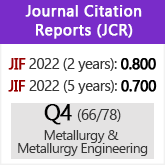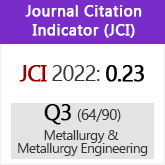Galvanized steel inhibition in saline médium by cerous chloride
DOI:
https://doi.org/10.3989/revmetalm.1998.v34.iExtra.724Keywords:
Cerium, Inhibitors, Galvanized steel, Electrochemical techniques, CorrosionAbstract
The addition of small amounts of cerous chloride, as inhibitor of hot dip galvanised steel corrosión in aerated 3,5% NaCl solutions is studied. The results found so far, carried out by electrochemical techniques and accelerated tests, show a clear decrease in the zinc dissolution rate. The analysis of polarization curves and specimen surface suggest, in accordance with literature, that cerium acts as a cathodic inhibitor, blocking the oxygen reduction centers. Alternate immersion tests developed an excellent behaviour of specimens pre-treated in cerium containing solutions, compared to those without treatments. A rich cerium film is responsible of the improvement in the protective properties. These results prove the possibilities of cerium as an alternative treatment to those based on chromates, which are very effective on these materials but highly toxic.
Downloads
Download data is not yet available.
Downloads
Published
1998-05-30
How to Cite
Serrano, F., & Damborenea, J. J. (1998). Galvanized steel inhibition in saline médium by cerous chloride. Revista De Metalurgia, 34(Extra), 127–131. https://doi.org/10.3989/revmetalm.1998.v34.iExtra.724
Issue
Section
Articles
License
Copyright (c) 1998 Consejo Superior de Investigaciones Científicas (CSIC)

This work is licensed under a Creative Commons Attribution 4.0 International License.
© CSIC. Manuscripts published in both the printed and online versions of this Journal are the property of Consejo Superior de Investigaciones Científicas, and quoting this source is a requirement for any partial or full reproduction.All contents of this electronic edition, except where otherwise noted, are distributed under a “Creative Commons Attribution 4.0 International” (CC BY 4.0) License. You may read here the basic information and the legal text of the license. The indication of the CC BY 4.0 License must be expressly stated in this way when necessary.
Self-archiving in repositories, personal webpages or similar, of any version other than the published by the Editor, is not allowed.

















